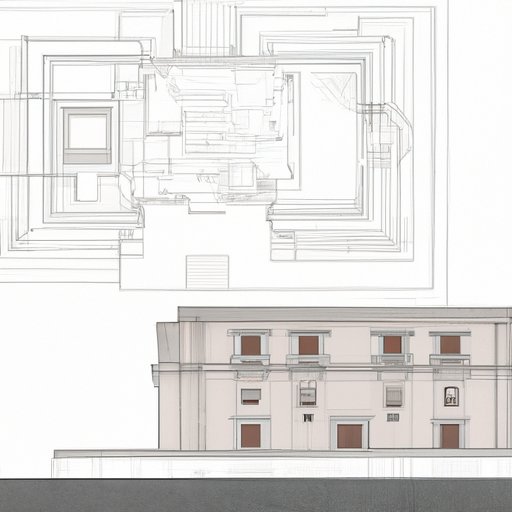Introduction
De Architectura, written by the Roman architect Vitruvius in the 1st century BC, is one of the oldest surviving architectural treatises in the world. It is an extensive work that covers a wide range of topics related to architecture, from design principles to construction methods. This article will explore the impact that De Architectura has had on modern architecture and urban planning, as well as its influence on early Renaissance architecture.

A Historical Overview of De Architectura
Vitruvius was a Roman military engineer who wrote De Architectura during the reign of Augustus Caesar. His work is divided into 10 books which cover topics such as proportions, materials, building techniques, and more. It is considered to be one of the most influential works on architecture ever written and has been studied for centuries.
At the time of its release, De Architectura was met with great acclaim. It was seen as an authoritative source on architecture and was used by many architects as a guide for their designs. It also served as a reference book for many later writers on architecture, including Leon Battista Alberti, Andrea Palladio, and Inigo Jones.
The Influence of De Architectura on Modern Architecture
Vitruvius’s principles of design are still relevant today and have had a lasting impact on modern architecture. He believed that all architecture should strive for three qualities: harmony and proportion, utilitas (utility), and firmitas (durability). These three principles can be seen in many modern buildings, from residential homes to skyscrapers.
Harmony and proportion are essential elements of good design. Vitruvius believed in using simple, balanced forms that were pleasing to the eye and that could be adapted to suit any purpose. He also believed in using strong, durable materials that would last for generations. These principles have been embraced by modern architects and can be seen in many of today’s buildings.
Utilitas is another important principle of Vitruvius’s design philosophy. He believed that buildings should be practical and serve a purpose, whether it be for shelter, storage, or other uses. This idea has been embraced by modern architects, who strive to create buildings that are functional as well as aesthetically pleasing.
Firmitas is the third principle of Vitruvius’s design philosophy. He believed that buildings should be constructed with quality materials and built to last. This idea is still relevant today, as many modern buildings use high-quality materials and construction methods to ensure that they will stand the test of time.
An Analysis of Vitruvius’s Principles of Design in De Architectura
Harmony and proportion are two of the most important principles of Vitruvius’s design philosophy. He believed that buildings should be designed in accordance with the golden ratio, which is a mathematical formula that produces aesthetically pleasing results. This idea has been embraced by modern architects, who strive to incorporate this ratio into their designs.
Utilitas is the principle of utility, or usefulness. Vitruvius believed that buildings should be practical and serve a purpose. This idea has been embraced by modern architects, who strive to create buildings that are both functional and aesthetically pleasing. Additionally, Vitruvius believed that buildings should be designed using natural materials whenever possible, which is another principle that modern architects have embraced.
Firmitas is the principle of durability. Vitruvius believed that buildings should be constructed with quality materials and built to last. This idea has been embraced by modern architects, who strive to use materials and construction methods that will ensure that their buildings will stand the test of time.
Exploring De Architectura’s Impact on Urban Planning
Vitruvius had much to say about urban planning in his treatise De Architectura. He believed that cities should be planned in accordance with certain principles, such as providing adequate space for public areas, ensuring access to basic services, and creating a pleasant environment. These principles have been embraced by modern urban planners, who strive to create cities that are livable, efficient, and sustainable.
Vitruvius also believed that cities should be designed in accordance with the principles of harmony and proportion. He believed that buildings should be arranged in such a way that they complement each other and that streets should be laid out in a logical and orderly fashion. This idea has been embraced by modern urban planners, who strive to create cities that are aesthetically pleasing as well as functional.

How De Architectura Shaped Early Renaissance Architecture
De Architectura had a profound influence on early Renaissance architecture. Vitruvius’s principles of design, such as harmony and proportion, were embraced by Renaissance architects, who sought to create buildings that were both aesthetically pleasing and functional. Additionally, Vitruvius’s writings provided inspiration for many of the innovations that characterized Renaissance architecture, such as the use of classical elements and the incorporation of mathematics into design.
Vitruvius’s ideas also influenced the development of urban planning during the Renaissance. His writings provided inspiration for the development of cities that were both functional and aesthetically pleasing. Renaissance cities were often designed in accordance with the principles of harmony and proportion, with streets laid out in a logical and orderly fashion.
Conclusion
De Architectura by Vitruvius is one of the oldest and most influential works on architecture ever written. It has had a lasting impact on modern architecture and urban planning, as well as on early Renaissance architecture. Vitruvius’s principles of design, such as harmony and proportion, have been embraced by modern architects and urban planners and have shaped the way we design and build today.
From its beginnings in the 1st century BC to its continued relevance in the modern age, De Architectura has played an important role in shaping the way we view architecture and design. It is a timeless work that will continue to inspire and inform future generations of architects and urban planners.
(Note: Is this article not meeting your expectations? Do you have knowledge or insights to share? Unlock new opportunities and expand your reach by joining our authors team. Click Registration to join us and share your expertise with our readers.)
